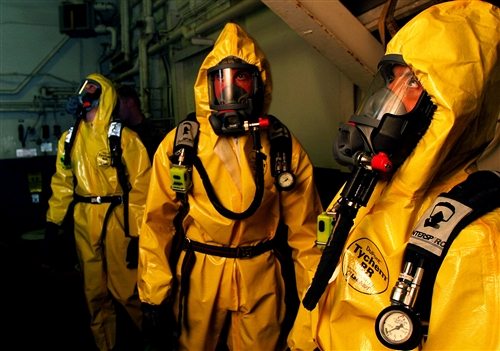Biological warfare agents pose more than a hypothetical threat to U.S. military servicemembers. Troops operate in hostile areas where they could come under attack from adversaries wielding bio-agents like anthrax and toxins. The first step in reacting to any such attack is knowing that it occurred. Quickly and accurately identifying the presence of airborne antigens can be difficult given their complexity, the presence of numerous similar microorganisms in the environment, and the fact that even minute quantities of a threat agent can cause infection.[i]
The Department of Defense (DoD) employs antibody-based biosensors as its immediate tool for quickly detecting antigens—antibodies bind to antigens—but these sensors have functional limitations that can leave warfighters at risk. The two biggest liabilities involve stability and affinity. Stability refers to a sensor’s ability to continue functioning as required over time and despite environmental conditions. Affinity refers to the tightness of the bond between an antibody and an antigen; the higher the affinity, the more sensitive a biosensor is over a wider range of threats. Existing DoD biosensors, while effective, have restricted shelf lives, are quickly rendered inoperable by high temperatures and offer limited affinity.
DARPA launched the Antibody Technology Program (ATP) in 2009 to address the technological limitations of current antibody-based biosensors. The program set out with two primary goals: achieve revolutionary improvements in the stability of antibodies over time, even in extreme conditions; and control affinity in biosensors to enable detection of numerous antigens by a single unit. ATP ended in 2012 having achieved both goals and with a plan in place to transition the technologies to DoD’s Critical Reagents Program, part of the Joint Program Executive Office – Chemical and Biological Defense (JPE-CBD), for biosensor deployment throughout the military services.
Specifically, DARPA performers demonstrated the ability to increase antibody temperature stability at 70 degrees Celsius (158 degrees Fahrenheit) to 48 hours, up from the current limit of five to ten minutes. When transitioned to DoD biosensors, these results are projected to eliminate the need for refrigeration while increasing the shelf life by a factor of 36, extending survivability at room temperature (approx. 25 degrees Celsius or 77 degrees Fahrenheit) from one month to approximately three years. DARPA also increased antibody affinity by a factor of 400, thus opening the door to vastly more sensitive, multiplexed biosensors that can test for numerous antigens.
Mildred Donlon, the DARPA program manager for ATP, explained the implications of the breakthroughs: “When you consider the locations of warfighters who have the most potential for biological weapons to be used against them, they are typically environments with extreme temperatures and harsh conditions, and the warfighters themselves are probably operating in small groups. If it’s going to be useful to these teams, DoD equipment needs to be ruggedized to survive conditions and be easy to use by non-experts. The ATP technology hits these goals.
“By removing temperature stability as a limiting factor, troops will now be able to carry sensors with them without worrying about refrigeration and wondering if the sensor will return an accurate reading. According to the Chemical Biological Medical Systems Joint Project Management Office at JPE-CBD, eliminating the need for cold-chain logistics in transport and deployment of sensors is estimated to save DoD in the range of $10 million per year,” Donlon said. “The new stability also means antibodies can be attached to new materials to make potentially more practical sensors to take the place of current beads and strips. Most importantly, by pairing more stable sensors with a huge increase in sensitivity, DARPA is giving troops the confidence to trust the results of what can be literally life-or-death measurements.”
ATP achieved these results by altering the amino acid sequences within the antibody molecules. Rather than creating an additive stabilizing material, ATP performers devised methods to make the altered amino acids an integral part of the structure of the antibody molecule.
“Antibody-based biosensors have been in use for roughly 30 years,” Donlon said. “DARPA used recent advances in understanding of protein structure and analysis to determine new ways to alter amino acids, integrate them into an antibody structure, and do so at a sustainable scale.”
DARPA partnered with the U.S. Army’s Edgewood Chemical Biological Center (ECBC) from the beginning of ATP, to first assist with evaluation of performer research proposals, then later in the program to provide ATP performers with unaltered antibodies, conduct testing on the performers’ altered antibodies, and validate results. To ensure that the production methods for modifying antibodies are scalable and cost effective, performers had to submit one-gram samples for testing. The positive results mean that existing DoD antibody stockpiles can be altered to incorporate the new properties of stability and high affinity.
Program performers for ATP included: Affomix Corp. (Branford, Conn.), purchased by Illumina, Inc. (San Diego, Calif.); AnaptysBio, Inc. (San Diego, Calif.); the Naval Research Laboratory (Washington, District of Columbia); StableBody Technologies, LLC (Lemont, Ill.); The University of Texas at Austin (Austin, Texas); and the ECBC (Aberdeen, Md.), which participated as the validation laboratory. AxioMx, Inc. (Branford, Conn.) was created to rapidly generate high-quality recombinant antibodies.










